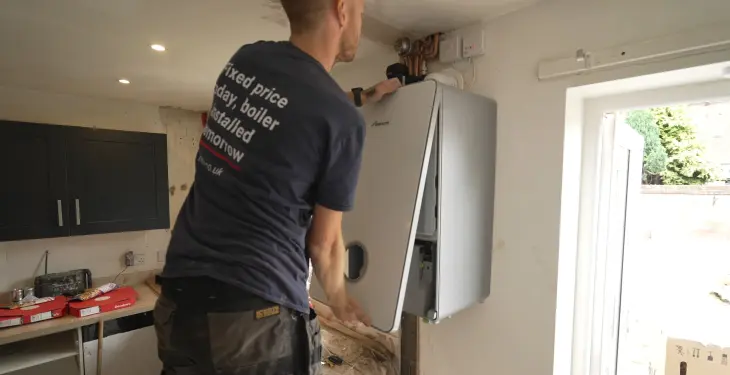

Written by Stephen Day
Gas Safe Engineer
Updated: 15th October, 2025
Understanding boiler error codes is essential in determining the proper course of action. The presence of an E133 code specifically highlights a safety feature in Baxi boilers that prevents operation if a fault is detected.
Get a new boiler quote, save up to £550 per year (0% APR available).
Encountering an E133 error code on a Baxi boiler can be a source of frustration for homeowners. This code indicates an ignition lockout or a problem with the boiler's gas supply, calling attention to potential issues that can disrupt normal operation.
The E133 error requires diagnostic procedures to understand the underlying cause, which may range from simple fixes like resetting the boiler to more complex faults that necessitate professional intervention.
Understanding boiler error codes is essential in determining the proper course of action. The presence of an E133 code specifically highlights a safety feature in Baxi boilers that prevents operation if a fault is detected.
Homeowners may perform basic troubleshooting, like checking for visible issues or trying a reset. However, complex repairs, especially those that deal with gas supply, should be conducted by a Gas Safe registered engineer to ensure safety and compliance with regulatory standards.
Get a quote in 60 seconds, fitted as fast as next day!
0% APR finance available.
A boiler error code is a specific diagnostic tool that signals to the user there is an issue within the heating system that requires attention. They serve as a valuable first step in the troubleshooting process.
Boiler error codes are alphanumeric sequences displayed on the control panel of a boiler. These codes are programmed to alert users to specific malfunctions or irregularities in the boiler's operation. Upon detection of a fault, the boiler's internal monitoring system generates a corresponding error code, which usually halts the operation to prevent damage or unsafe conditions.
Fault: The term signifies a malfunction within the boiler's components or system.
Error Code: This is the specific code related to a particular fault.
Boiler Maintenance: Regular check-ups to ensure the system operates efficiently.
Comprehending what different error codes represent is crucial for effective boiler maintenance. They provide immediate insights into the nature of a problem, which can:
Facilitate faster troubleshooting.
Help owners and technicians take appropriate measures to rectify the issue.
Grasping the meaning behind these codes can thus mitigate extensive damage, promote safety, and extend the lifespan of the boiler. Regular maintenance, coupled with an understanding of fault codes, ensures that a boiler remains in good working condition, maintains performance levels, and adheres to safety standards.
When a Baxi boiler displays the E133 error code, it signifies a critical issue relating to gas supply or ignition. This code requires immediate attention to ensure the boiler's safe and efficient operation.
Baxi is a trusted brand, but others perform just as well. Explore our best boiler brands guide to compare top-rated options for reliability and value.
E133 is a specific fault code that appears on Baxi boilers when the unit has a problem with gas supply or ignition process. It is a prevalent issue that stops the boiler from functioning correctly until rectified.
The E133 error indicates several potential causes:
Gas Supply Issues: A common reason for seeing E133 on the display is a disruption in gas supply to the boiler. This could be due to the mains supply being turned off or a fault within the supply line.
Ignition Failures: If the boiler attempts to ignite but fails, this can trigger the E133 error code. Potential culprits include damaged ignition electrodes or issues with the boiler's printed circuit board (PCB).
Faulty Gas Valve: The gas valve controls the flow of gas into the burner. A defective valve may not open properly, leading to ignition problems.
Condensate Pipe Problems: A frozen condensate pipe or blockage can lead to a build-up of condensation, triggering the E133 fault.
Pressure Irregularities: Incorrect gas pressure either too high or too low may cause the boiler to lock out and display the E133 error.
These issues are safety mechanisms designed to prevent damage to the boiler or risk to occupants, thus requiring immediate inspection and repair by a qualified engineer.
Recognising the signs and symptoms of the E133 error code is essential for prompt and effective troubleshooting of a Baxi boiler. This specific fault code indicates an ignition issue or problems related to the gas supply.
Control Panel Notification: The most immediate sign that an E133 fault has occurred is the display of the error code itself on the boiler's control panel. The appearance of 'E133' indicates the boiler has recognised a problem and is alerting you to take action.
Ignition Failure: When the boiler attempts to ignite but fails, it's a clear symptom. This malfunction could be intermittent or consistent, resulting in the inability to heat water or warm the household.
Absence of Flame: If you observe that there is no flame when the boiler operates, this could be a direct sign of the E133 error. The absence of a flame signifies that ignition has not been successful, despite the boiler's attempts to initiate the process.
Fluctuating Water Temperature: Another symptom associated with the E133 fault is water temperature inconsistency. Difficulty maintaining a stable temperature could imply an underlying ignition fault.
Boiler Lockout: In some events, the boiler may enter a safety lockout mode following several unsuccessful ignition attempts. This safety feature prevents further attempts that could potentially be unsafe without resolving the error.
The presence of one or multiple symptoms should prompt further investigation and likely, intervention by a qualified engineer to ensure the continued function and safety of the Baxi boiler system.
Dealing with a Baxi Boiler E133 error code can be a bit technical, but certain steps can be safely performed at home to resolve the issue without the immediate need for professional intervention.
Firstly, resetting the boiler can sometimes resolve the E133 error. The user can attempt this by locating and pressing the reset button on the boiler interface. If the error persists, the homeowner can also check the gas supply. They should ensure that the gas stopcock is fully open and that there is gas flowing into the house by testing other gas appliances. Additionally, a routine examination and cleaning of the ignition electrode might be in order, as a dirty electrode can prevent successful ignition.
Press the reset button on your boiler.
Confirm the gas supply is active; other gas appliances should be working.
Clean the ignition electrode carefully to remove any buildup.
However, it's important to know when to step back. If you've conducted the basic checks and resets without any change, it's time to consider professional repair. Especially if the issue might involve intricate parts such as the printed circuit board (PCB), professional expertise is paramount. Moreover, tampering with gas appliances without the proper knowledge and certification is not only likely to void any warranty but also poses serious safety risks.
Avoid DIY if there's no change after a reset.
Don’t attempt repairs if you suspect a faulty PCB.
Prioritise safety and seek professional help if unsure.
The Baxi boiler E133 error code signals an issue with the gas supply, necessitating expert analysis. Accurate diagnosis and repair by a Gas Safe engineer ensures safety and compliance with legal regulations.
In the event of an E133 error, first ensure your gas supply is active and the boiler reset attempt has been made. If the issue persists beyond these initial checks, professional assistance is required. A Gas Safe registered engineer should be contacted if:
The boiler fails to operate after a reset.
There is evidence of a continuous gas supply malfunction.
Annual servicing has not been carried out to identify this issue earlier.
Situations involving gas appliances carry inherent risks. Consequently, expertise from a qualified engineer is imperative to rectify the E133 code safely.
All of iHeat’s engineers are fully qualified and Gas Safe, ensuring a swift and safe installation.
A Gas Safe registered engineer is a technician certified to work with gas appliances. Such accreditation is both a legal requirement and a guarantee that the engineer has the necessary skills to manage gas safety effectively. The importance of their role includes:
Ensuring the boiler repair complies with current safety standards.
Possessing the capability to detect and remedy faults beyond the scope of lay knowledge.
Implementing fixes that prevent future complications.
Considering that a compromised gas appliance can lead to hazardous situations, the appointment of a Gas Safe engineer represents an investment in both safety and peace of mind. Regular maintenance and timely professional repair can extend the life of a boiler, ensuring it operates efficiently and without risk to occupants.
Diagnosing and repairing the E133 error code in Baxi boilers involves several variables, which influence the overall cost. One may experience a range of expenses depending on the complexity of the fault and the repair interventions needed.
The cost of repairing an E133 error code on a Baxi boiler typically fluctuates between £150 to £500. This range accounts for the most straightforward fixes, such as resetting the boiler or thawing a frozen condensate pipe, to more costly repairs involving part replacements.
Minor Fixes: £150 - £200
Resetting the boiler
Thawing the condensate pipe
Major Repairs: £300 - £500
Replacing the gas valve
Repairing or replacing the printed circuit board (PCB)
These figures include the fees charged by Gas Safe registered engineers for their service and time. It is important to note that costs can vary by region and the engineer's level of experience.
Several factors can influence the final bill for rectifying the E133 fault:
Extent of Damage: If the boiler has sustained significant damage or wear, this could necessitate more extensive repairs or even a full replacement of parts.
Cost of Parts: Some parts, such as the gas valve or electrodes, may be pricier due to their function or the boiler model.
Engineer’s Rates: Charges may vary based on the engineer's expertise and reputation.
Emergency Call-outs: If one requires immediate assistance outside of normal working hours, this will likely increase the cost.
Boiler Age and Condition: An older boiler may have out-of-production parts, making repairs more expensive.
Payment Method: Some engineers might offer different rates for payment methods such as credit or if the customer has a pre-paid meter.
Prices may also be impacted by whether the repair is a short-term fix or a long-term solution, with the latter potentially offering better value for money despite a higher upfront expense.
When faced with an E133 error code on a Baxi boiler, it is crucial to understand whether a simple repair will suffice or if it's time for a new boiler. This section outlines the key considerations.
Diagnosing the severity of an E133 error is essential. If the issue lies with a simple fault, such as a blocked gas valve or a defective ignition lead, a repair by a Gas Safe registered engineer might resolve the problem.
If repairs are becoming frequent, it may be time to upgrade. See our best combi boilers list for this year’s most efficient replacements.
Boilers, much like any home appliance, have an expected lifespan—typically between 10 to 15 years for brands like Baxi and Potterton. Replacement is usually considered when the boiler reaches this age range, particularly if performance declines or breakdowns become frequent.
If your boiler’s nearing the end of its life, our new boiler cost guide explains what to budget for in 2025 across combi, system and regular models.
The discussion on the Baxi boiler E133 error code demystifies its common causes and the steps required for troubleshooting and resolution.
The E133 error code is typically associated with problems in the gas supply or ignition system. Identifying the root cause is essential for a homeowner and may involve checking for a frozen condensate pipe, blocked gas valve, or faulty ignition leads.
Critical steps for addressing the issue include:
Thawing a Frozen Condensate Pipe: If the condensate pipe is frozen, carefully pouring warm water over it can resolve the problem. Following this, resetting the boiler is advisable.
Inspecting the Gas Valve: The gas valve should be checked for blockages. If the valve is faulty, a Gas Safe registered engineer must be consulted.
Examining Ignition Leads: Damaged or defective ignition leads can prevent proper ignition. These should be inspected and replaced by a qualified individual if found to be the issue.
Preventative measures are also crucial to avoid future occurrences of the E133 fault code. Regular maintenance and servicing can help ensure that components such as the condensate pipe and gas valve remain in good working order, precluding the need for emergency repairs.
It is imperative that any rectification is carried out by a competent engineer.
Get a quote in 60 seconds, fitted as fast as next day!
0% APR finance available.
Last updated: 15th October, 2025

Written by Stephen Day
Gas Safe Engineer at iHeat
Stephen Day is a Gas Safe registered and FGAS certified engineer with over 20 years of hands-on experience in the heating, cooling, and renewable energy industry, specialising in boiler installations, air conditioning, and heat pump systems.
LinkedInArticles by Stephen Day are reviewed by iHeat’s technical team to ensure accuracy and reliability.

22nd December, 2025
Based on data from over 7000 boiler installations completed by iHeat in the past 12 months...
 Read Article
Read Article

22nd December, 2025
Here’s a quick roundup of the best combi boilers for 2026.
 Read Article
Read Article

22nd December, 2025
When your old boiler breaks down and it comes time to replace it with a new one, it might...
 Read Article
Read Article
No obligation. Takes less than 60 seconds.